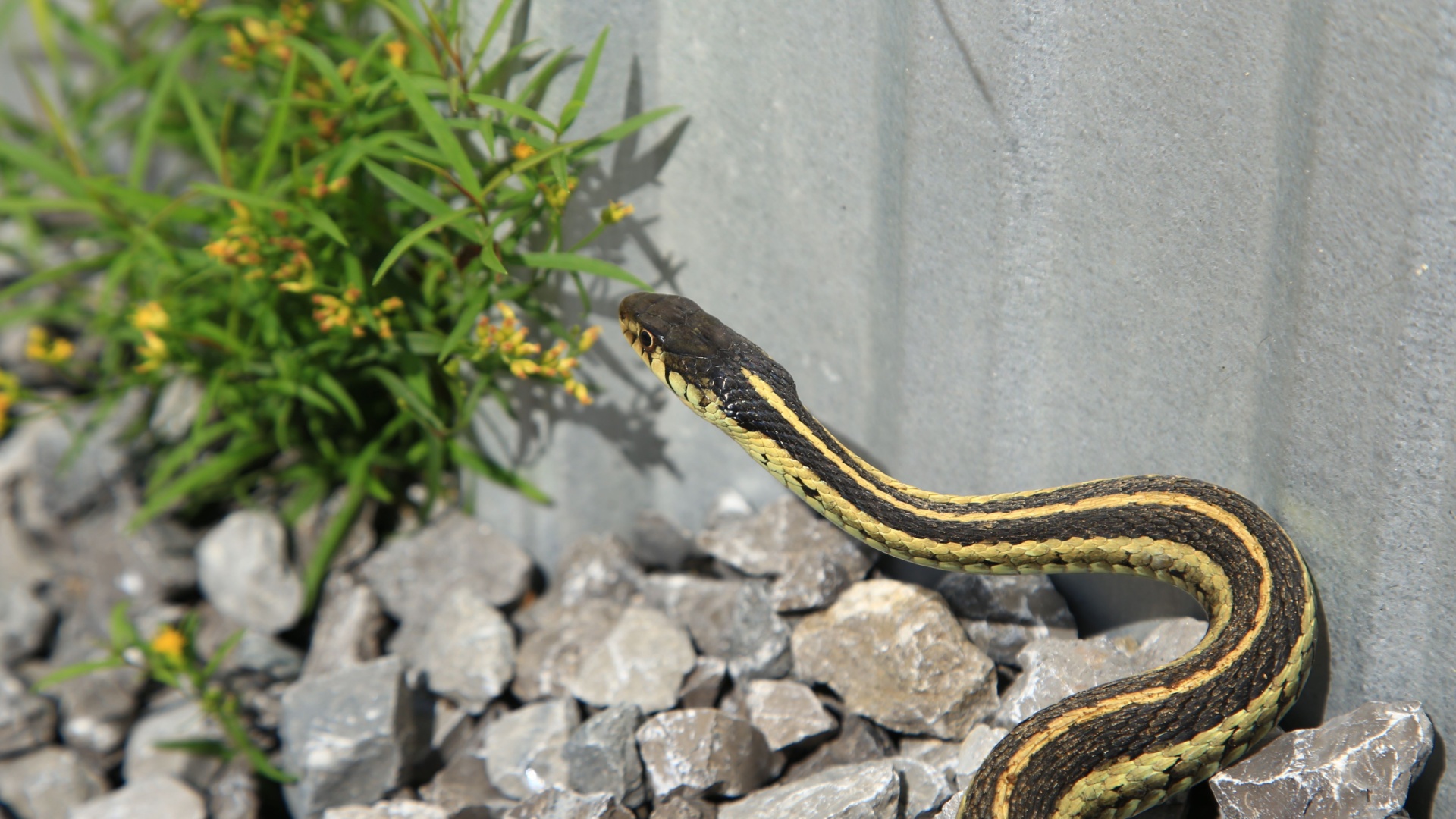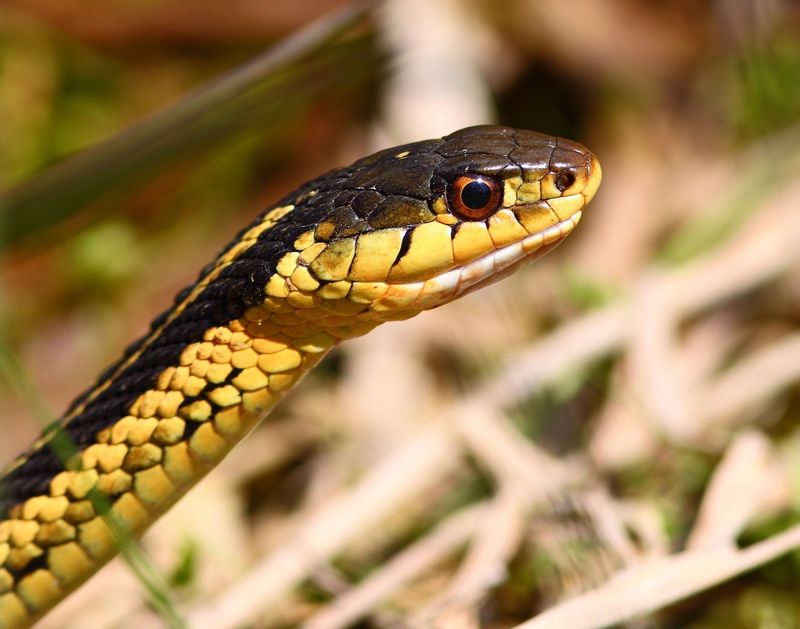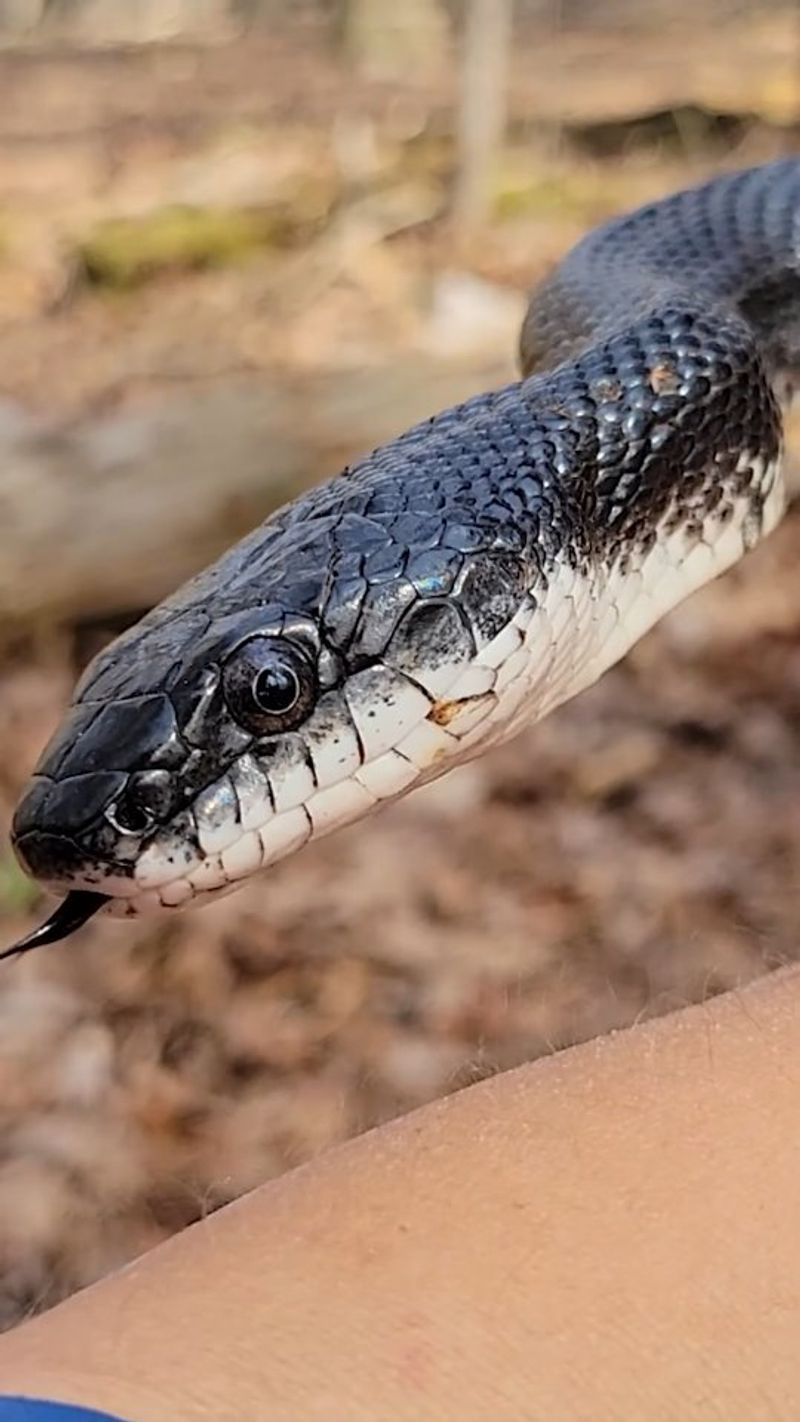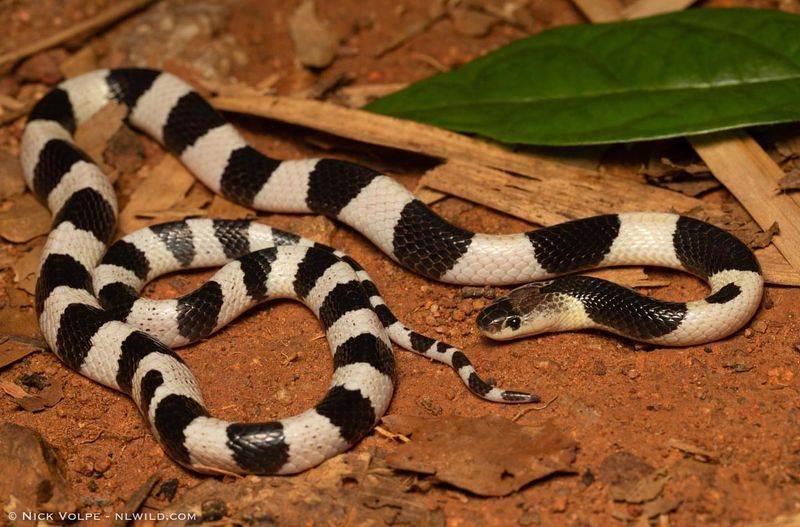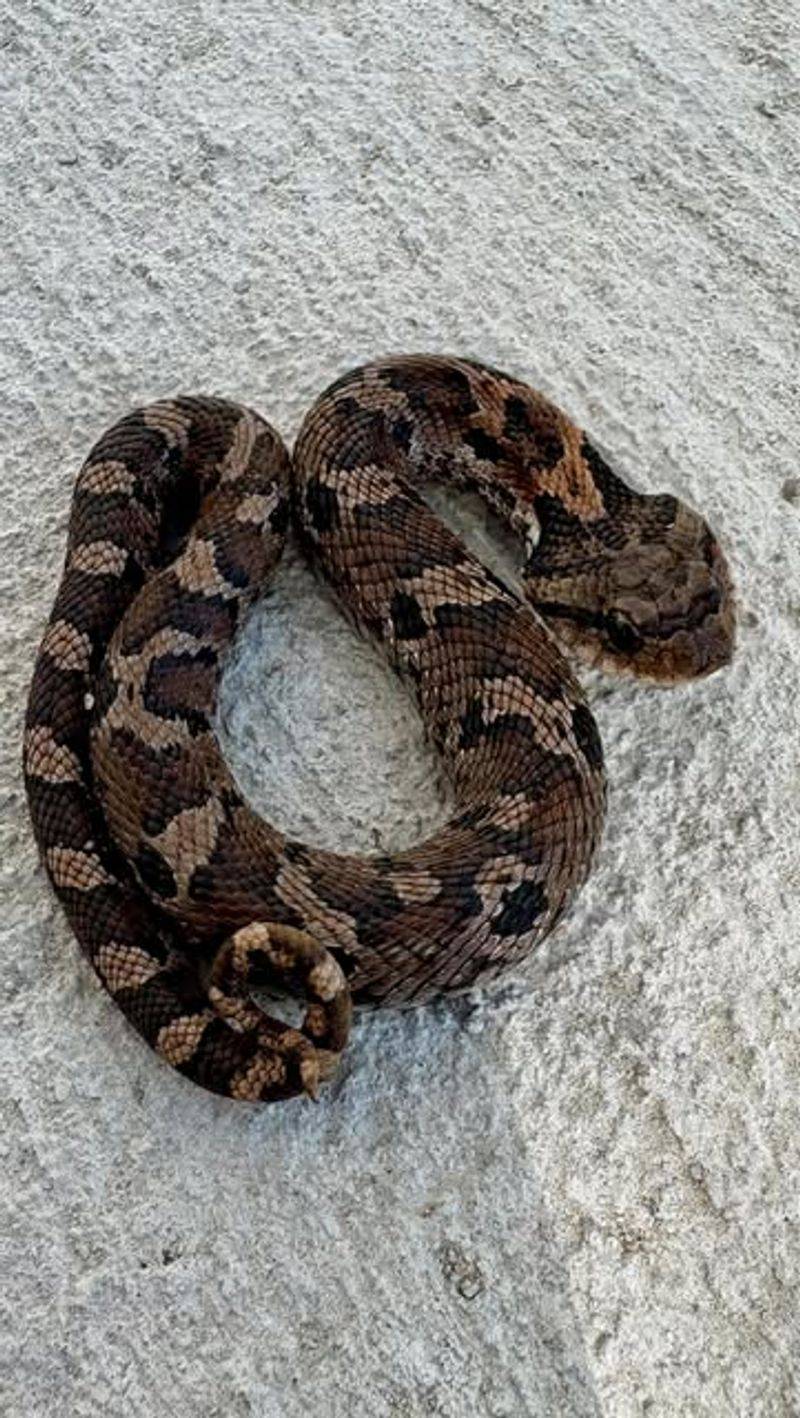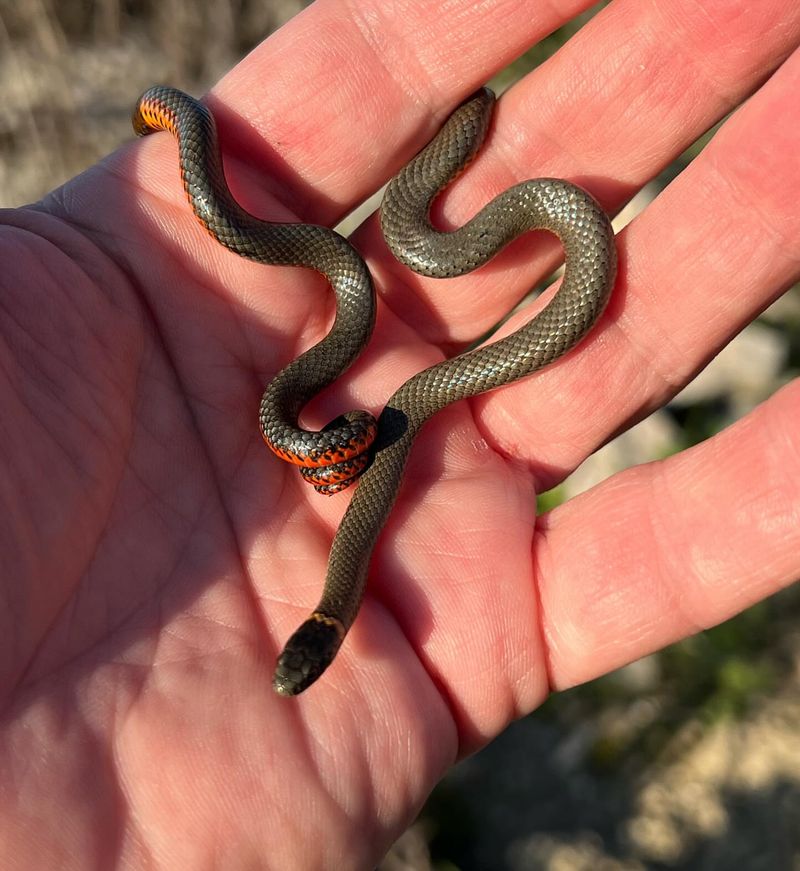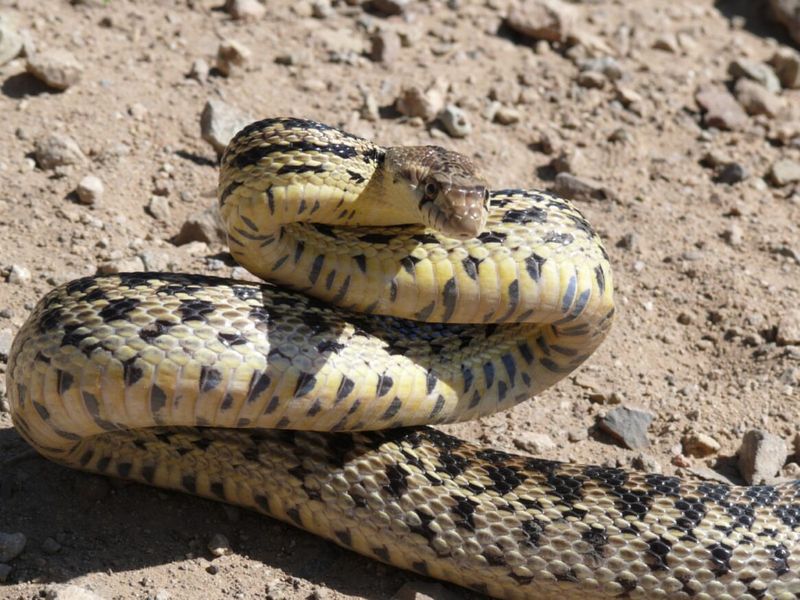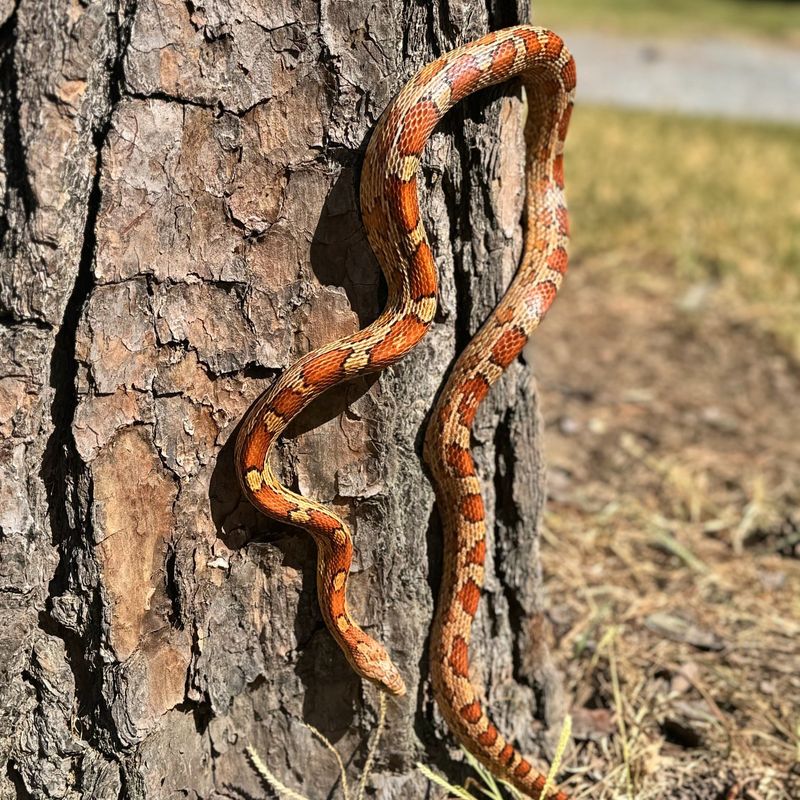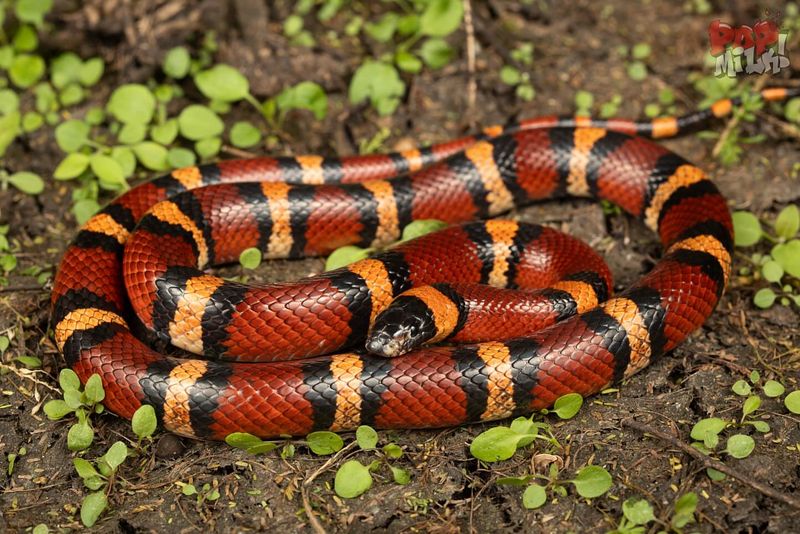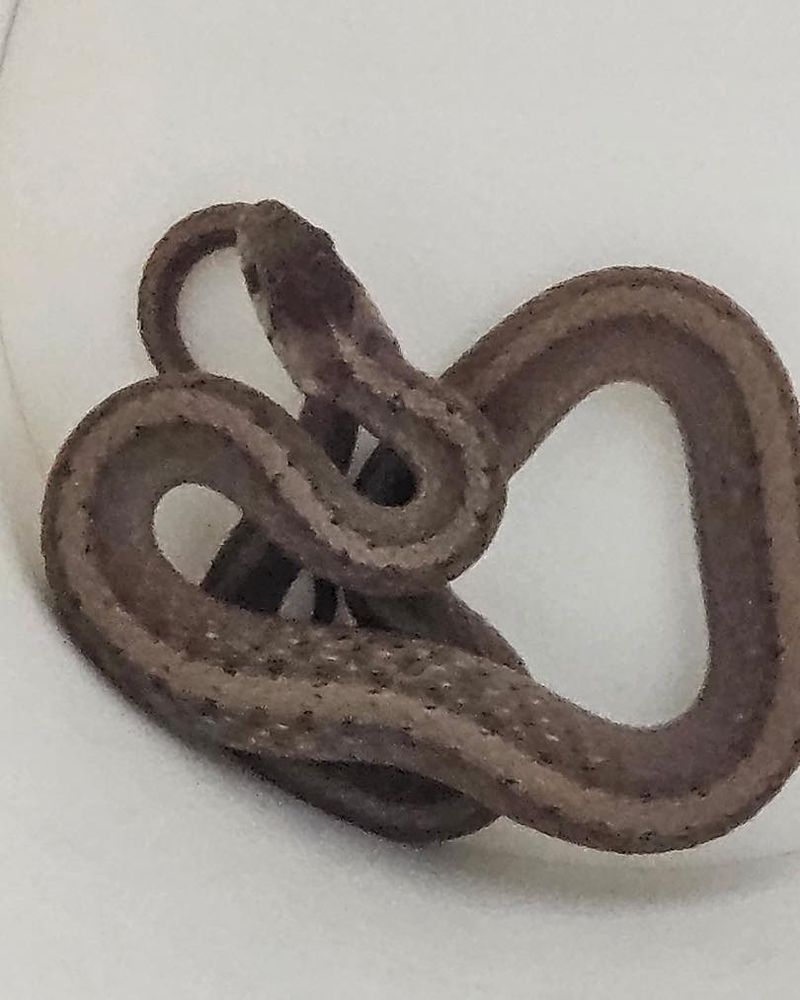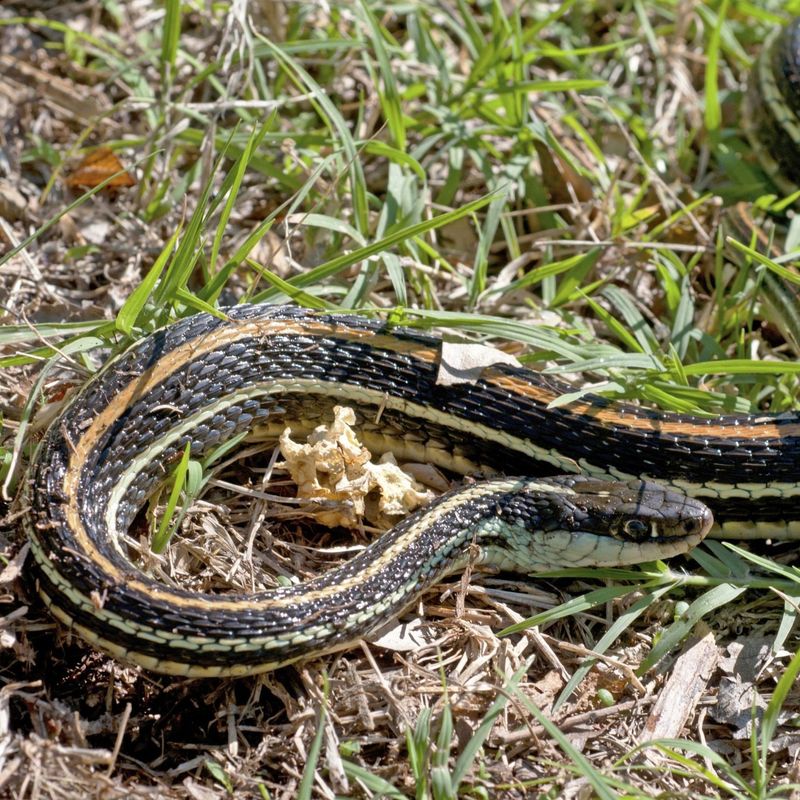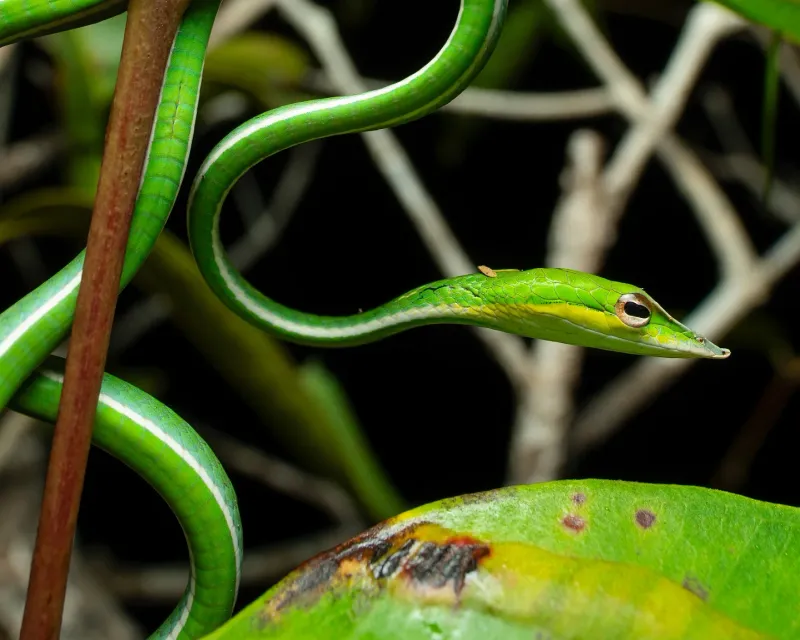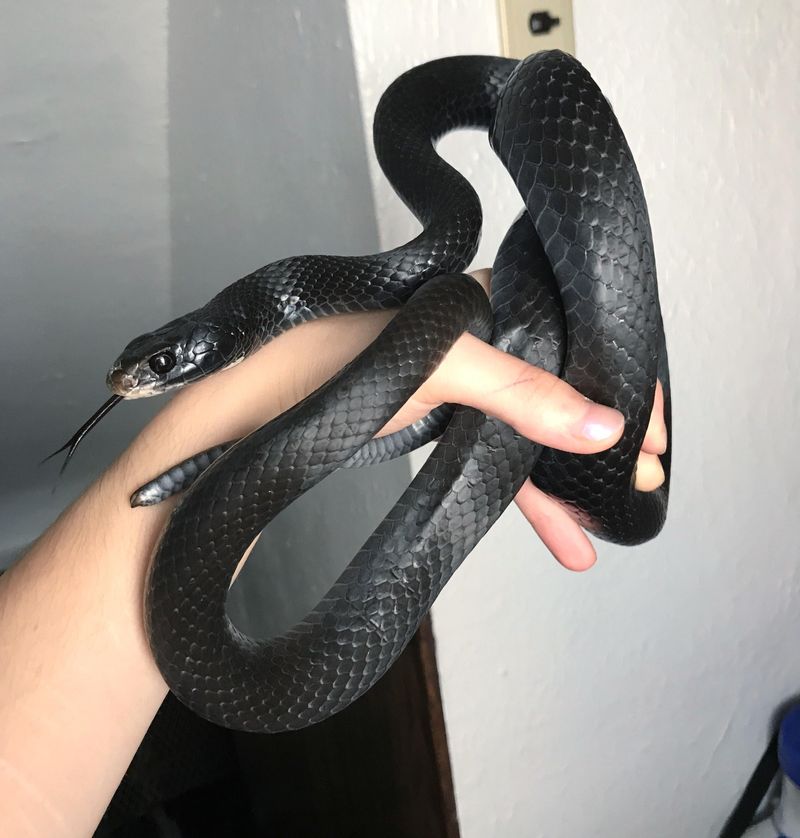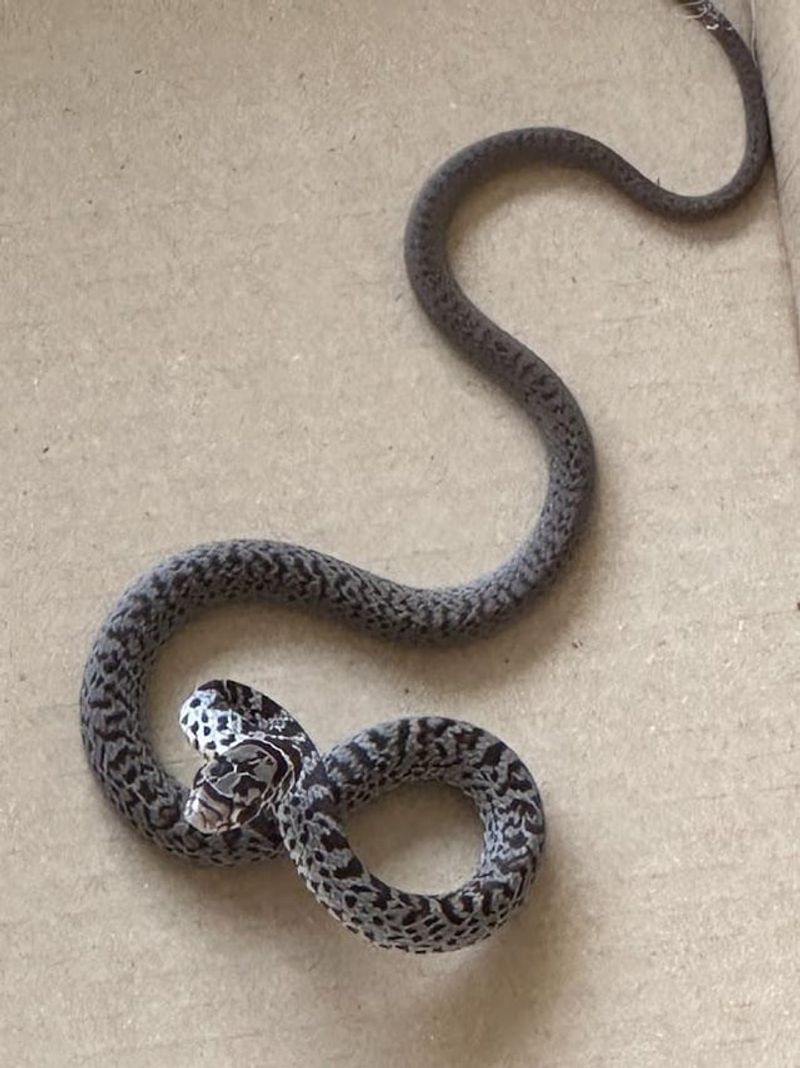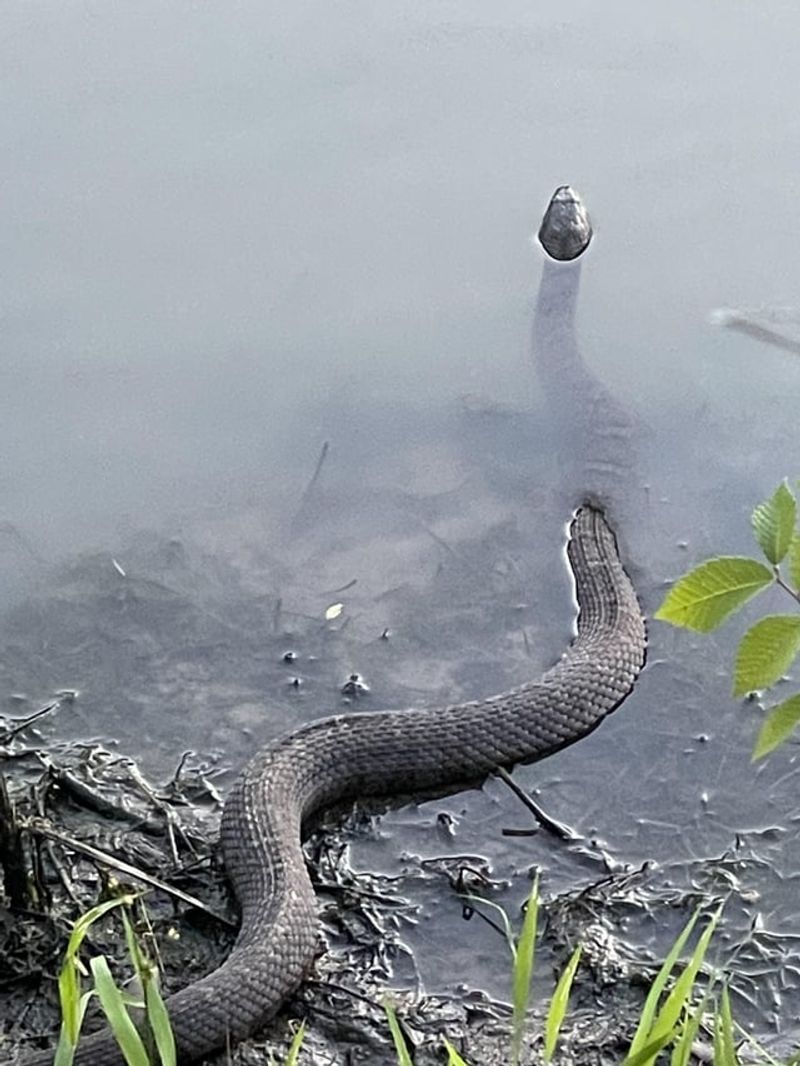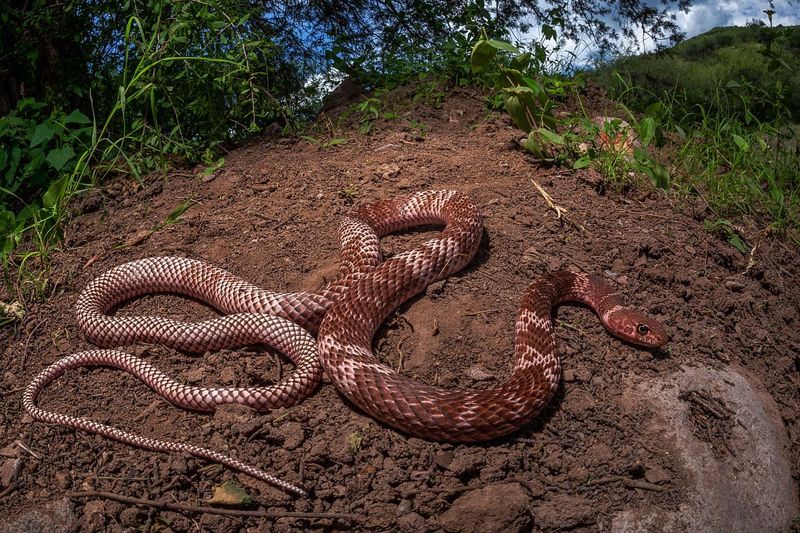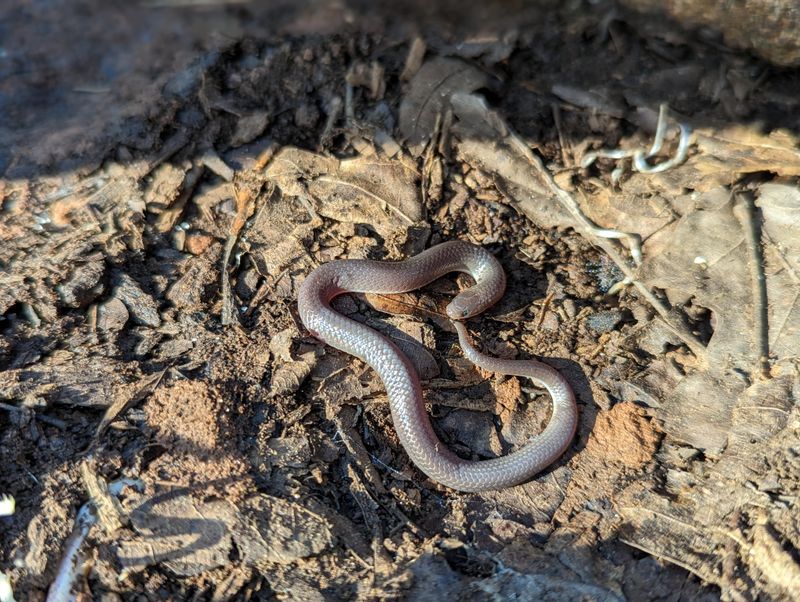Spot a snake and your first instinct might be to panic—but not every slitherer is a threat. In fact, most backyard snakes are harmless and even helpful. The key is knowing who’s who.
This guide will help you identify 16 non-poisonous snakes you might find in your yard—so you can stay calm, safe, and maybe even let them stick around.
1. Garter Snake: The Garden Helper
Slithering through garden beds with their distinctive yellow or white stripes running lengthwise down a dark body, garter snakes are backyard favorites. These slender reptiles typically grow 2-3 feet long and have keeled scales that give them a slightly rough appearance.
Garter snakes are active during daylight hours, making them easier to spot than many other species. They’re excellent helpers in the garden, eagerly consuming slugs, earthworms, and small rodents that might damage your plants.
2. Rat Snake: Nature’s Rodent Control
Sporting a muscular body that can reach impressive lengths of 3-8 feet, rat snakes are the unsung heroes of pest management. Their coloration varies widely depending on region—black in the east, yellow with four dark stripes in the central states, and patterned gray in the west.
Despite their intimidating size, these constrictors are surprisingly shy around humans. Farmers have long appreciated rat snakes for their natural talent at controlling rodent populations, making them welcome residents in rural areas.
3. Kingsnake: The Snake Eater
Draped in striking bands of black, white, and sometimes red, kingsnakes are nature’s snake-eating specialists. Their powerful bodies can be identified by smooth, glossy scales and a pattern that completely encircles their body (unlike coral snakes, whose red and yellow bands touch).
Remember the rhyme: “Red touch black, friend of Jack; red touch yellow, kill a fellow.” Kingsnakes are immune to the venom of other snakes, including rattlesnakes, which they happily include in their diet. This makes them valuable allies in keeping venomous snake populations in check.
4. Hognose Snake: The Drama Queen
Named for their upturned snout that resembles a pig’s nose, hognose snakes are the theater performers of the reptile world. Their stout bodies display blotchy patterns in browns, tans, and blacks, perfectly camouflaging them among fallen leaves.
When threatened, these dramatic reptiles put on an impressive show—flattening their necks like cobras, hissing loudly, and even playing dead by rolling onto their backs with mouths open. Despite this scary performance, they’re completely harmless to humans and primarily eat toads and frogs.
5. Ringneck Snake: The Tiny Jewel
Barely reaching 10-15 inches long, ringneck snakes are petite backyard treasures. Their smooth, dark bodies (usually black, slate, or dark brown) contrast beautifully with a vibrant orange or yellow ring around their neck and matching bright belly.
Often found under rocks, logs, or garden debris, these secretive snakes are most active at night. They feast on earthworms, salamanders, and small insects, making them beneficial garden residents. Their tiny size and gentle disposition make them completely harmless to humans.
6. Gopher Snake: The Rattlesnake Mimic
Masters of deception, gopher snakes have evolved to mimic rattlesnakes when threatened—flattening their heads, vibrating their tails, and hissing loudly. Their cream or tan bodies feature large brown or black blotches down the back and smaller spots along the sides.
Unlike their venomous lookalikes, gopher snakes have round pupils and lack rattles. These powerful constrictors can grow 4-7 feet long and are exceptional burrowers. Farmers appreciate their voracious appetite for gophers, mice, and rats that damage crops and gardens.
7. Corn Snake: The Colorful Climber
Graced with vibrant orange or reddish-brown bodies adorned with bold red or brown blotches outlined in black, corn snakes are among North America’s most beautiful serpents. Their bellies display a distinctive black-and-white checkerboard pattern that’s unmistakable.
Excellent climbers, these snakes are often found in trees or scaling walls of barns and outbuildings. Docile by nature, corn snakes rarely bite even when handled. Their name comes from their habit of hunting rodents around corn storage areas on farms.
8. Milk Snake: The Barnyard Friend
Adorned in striking bands of red, black, and cream or yellow, milk snakes have been wrongly accused of stealing milk from cows—a myth that gave them their name. In reality, these colorful constrictors were simply hunting mice in barns where dairy cows were kept.
Milk snakes belong to the kingsnake family and share their cousin’s immunity to venom. Their smooth scales and shiny appearance make them visually distinctive. Though they resemble coral snakes, milk snake bands follow the pattern “red touch black, friend of Jack.”
9. Brown Snake: The Tiny Garden Dweller
Don’t let the plain name fool you—these diminutive serpents rarely exceed 12 inches and perform valuable garden services. Brown snakes wear subtle tan or brown coats, often with two parallel rows of small dark spots and a light stripe down their back.
Incredibly gentle creatures, brown snakes specialize in eating garden pests like slugs, snails, and earthworms. They’re commonly found under mulch, garden stones, or flower pots. Despite their small size, they’re hardy enough to thrive even in urban environments where few other snakes can survive.
10. Ribbon Snake: The Waterside Resident
Sleek and elegant, ribbon snakes resemble their garter snake cousins but with more refined features. Their slender bodies showcase three bright yellow or white stripes running down a chocolate-brown or black background, with the side stripes positioned higher on the body than a garter’s.
Almost always found near water, these graceful swimmers hunt tadpoles, small fish, and frogs along pond edges and stream banks. Ribbon snakes have longer tails than garter snakes and appear more delicate overall. Their preference for aquatic habitats makes them less common in typical backyards unless water features are present.
11. Green Snake: The Living Vine
Perfectly camouflaged among leaves and grass, smooth green snakes are like living plant stems with their uniform bright green coloration and cream or yellow bellies. These slender beauties rarely exceed 2 feet in length and have smooth scales that give them a satiny appearance.
Frequently mistaken for vines when motionless, green snakes are insect specialists that feast on grasshoppers, crickets, and caterpillars. Unlike many snakes that flee when approached, green snakes often freeze in place, relying on their exceptional camouflage. Their gentle temperament has earned them the nickname “grass snake” among gardeners.
12. Black Racer: The Speed Demon
Living up to their name, black racers are among the fastest snakes in North America, capable of traveling at speeds up to 4 mph. Their sleek bodies are solid black or dark gray with white chins and bellies, and they can reach impressive lengths of 3-5 feet.
Unlike many non-venomous snakes that flee or freeze when threatened, racers may stand their ground and even chase intruders! Don’t worry though—they’re harmless despite their bold attitude. With excellent daytime vision, these active hunters pursue lizards, rodents, and even other snakes across open areas.
13. Pine Snake: The Loud Hisser
Built like tanks with thick, muscular bodies reaching 4-6 feet long, pine snakes are impressive diggers that create extensive burrow systems. Their light background color (usually white, tan, or yellow) is decorated with bold black or brown blotches that may merge into stripes near the tail.
When disturbed, pine snakes are famous for their extraordinarily loud hissing—they’re among the noisiest of all North American snakes! This defensive display, combined with vibrating tails and flattened heads, often causes them to be mistaken for rattlesnakes. Despite the show, they’re beneficial predators specializing in pocket gophers and other burrowing rodents.
14. Water Snake: The Pond Patroller
Often misidentified as cottonmouths, northern water snakes are thick-bodied aquatic specialists with variable coloration—typically brown, gray, or reddish with darker crossbands or blotches that often fade as they age. Their keeled scales give them a rough, non-shiny appearance.
Masters of aquatic environments, water snakes are excellent swimmers that hunt fish, frogs, and crayfish. Unlike the venomous cottonmouth, water snakes have round pupils and lack the facial pit between eye and nostril. Though defensive when cornered, these common backyard pond residents just want to be left alone to patrol their watery territory.
15. Coachwhip: The Desert Racer
Resembling braided leather whips, coachwhips are among America’s longest snakes, sometimes exceeding 8 feet! Their coloration transitions dramatically from dark brown or black near the head to lighter tan or pink toward the tail, creating a whip-like appearance.
Lightning fast and surprisingly intelligent, coachwhips actively hunt during daylight hours with their heads raised, scanning for prey. Unlike most snakes, they have excellent vision and may even stand tall on their coiled bodies to get a better view. Though intimidating, they’re harmless to humans and primarily eat lizards, rodents, and birds.
16. Earth Snake: The Underground Specialist
Small and secretive, earth snakes rarely exceed 12 inches and spend most of their lives beneath the soil surface. Their uniform brown, gray, or reddish bodies lack distinctive markings except for a slightly lighter belly, making them easy to overlook.
Equipped with pointed snouts perfect for burrowing, earth snakes create tunnel networks where they hunt earthworms and soft-bodied insects. Gardeners often discover these shy reptiles when turning compost or moving rocks. Despite their startling appearance, earth snakes are completely harmless and typically freeze rather than flee when exposed.

